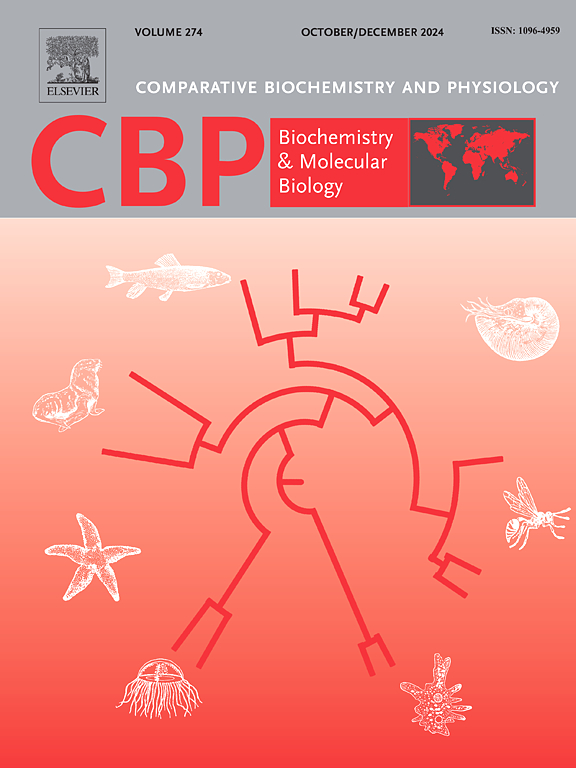Hepatic protective effects and oxidative stress modulation via gene expression in zebrafish (Danio rerio) fed with Synechococcus elongatus PCC 7942 as a functional feed additive
IF 1.9
3区 生物学
Q4 BIOCHEMISTRY & MOLECULAR BIOLOGY
Comparative Biochemistry and Physiology B-Biochemistry & Molecular Biology
Pub Date : 2025-05-11
DOI:10.1016/j.cbpb.2025.111111
引用次数: 0
Abstract
The inclusion of cyanobacteria in aquafeeds is a sustainable alternative to traditional fishmeal. This study evaluated the effects of Synechococcus elongatus PCC 7942 supplementation on intestinal morphology, liver histopathology, and antioxidant gene expression in zebrafish (Danio rerio). Fish were fed a commercial diet (CF) or the same diet supplemented with S. elongatus (EF) for 35 days. Liver histopathology revealed that 62 % of fish in the CF group exhibited generalized liver alteration, while fish in the EF group showed a lower frequency of generalized alteration (31 %) and a higher frequency of multifocal lesions (46 %), suggesting improved hepatic homeostasis. Intestinal morphometry showed no significant changes in villus length between groups. Gene expression analysis demonstrated a significant downregulation of xenobiotic metabolism genes (cyp1a, gst), antioxidant defense genes (sod1, sod2, cat), and steroid metabolism (cyp19a1a) in fish fed S. elongatus, except for gpx, which remained unchanged. The reduction in antioxidant gene expression, along with improved liver histology, suggests a lower oxidative stress in the EF group, likely due to synergistic effects of S. elongatus in mitigating oxidative damage. These findings indicate that S. elongatus supplementation does not impair intestinal morphology or liver function but supports hepatic homeostasis by reducing oxidative stress and modulating liver histopathology. This highlights its potential as a functional feed additive in aquaculture.
长聚球菌PCC 7942作为功能性饲料添加剂对斑马鱼肝脏保护作用及氧化应激的基因表达调控
在水产饲料中加入蓝藻是传统鱼粉的可持续替代品。本研究评价了添加长聚球菌PCC 7942对斑马鱼肠道形态、肝脏组织病理学和抗氧化基因表达的影响。分别饲喂商品饲料(CF)和在相同饲料中添加长形棘鱼(EF) 35 d。肝脏组织病理学显示,CF组62%的鱼表现出全身性肝脏改变,而EF组的鱼表现出较低的全身性改变频率(31%)和较高的多灶性病变频率(46%),表明肝脏稳态得到改善。肠道形态测定显示各组间绒毛长度无明显变化。基因表达分析显示,除了gpx保持不变外,长形梭鱼的外源代谢基因(cyp1a、gst)、抗氧化防御基因(sod1、sod2、cat)和类固醇代谢基因(cyp19a1a)均显著下调。抗氧化基因表达的减少,以及肝脏组织学的改善,表明EF组的氧化应激较低,可能是由于长形葡萄球菌在减轻氧化损伤方面的协同作用。这些研究结果表明,长形葡萄球菌的补充不会损害肠道形态或肝功能,而是通过减少氧化应激和调节肝脏组织病理学来支持肝脏稳态。这突出了其作为水产养殖功能性饲料添加剂的潜力。
本文章由计算机程序翻译,如有差异,请以英文原文为准。
求助全文
约1分钟内获得全文
求助全文
来源期刊
CiteScore
4.60
自引率
4.50%
发文量
77
审稿时长
22 days
期刊介绍:
Comparative Biochemistry & Physiology (CBP) publishes papers in comparative, environmental and evolutionary physiology.
Part B: Biochemical and Molecular Biology (CBPB), focuses on biochemical physiology, primarily bioenergetics/energy metabolism, cell biology, cellular stress responses, enzymology, intermediary metabolism, macromolecular structure and function, gene regulation, evolutionary genetics. Most studies focus on biochemical or molecular analyses that have clear ramifications for physiological processes.

 求助内容:
求助内容: 应助结果提醒方式:
应助结果提醒方式:


